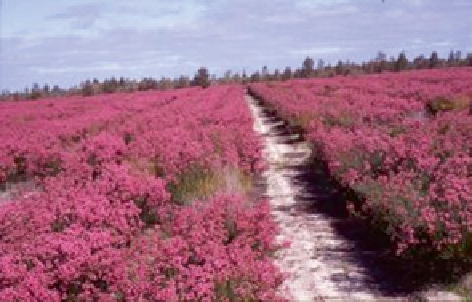Agriculture Reference
In-Depth Information
Fig. 12.5
Fields of cultivated
Geraldton wax (
Chamelau-
cium uncinatum
) flowers in
Western Australia. (Photo
courtesy of K. Seaton,
Department of Agriculture
and Food, Western Australia)
cultivars. The
Impatiens
-New Guinea hybrids have become a very popular sum-
mer bedding plant similar to petunias (von Hentig
1995
), and in general new cul-
tivars of
Impatiens
have been more popular with 9 million pots sold in the US in
2010 (APIH/Union Fleurs
2011
).
There have also been successes in hybridising Geraldton wax (
Chamelaucium
spp
.
) (Growns et al.
2000
; Shan and Seaton
2009
), teatree (
Leptospermum
spp
.
) and
kangaroo paw (
Anigozanthos
spp.) from Australian wildflower collections. Some
of these plants, such as Geraldton wax hybrids, are now being grown commercially
as cut flowers in California, Israel and Peru as well as Australia (Fig.
12.5
).
Breeding can involve simple crosses to more complex processes such as early
embryo rescue and tissue culture to overcome dormancy restraints to germination.
Breeding can also involve direct intervention to overcome pollen-ovary incompat-
ibility when parents from wide species are to be hybridised. Somatic hybridisation
techniques are being applied to
Chamelaucium
breeding to produce wide hybrids
(Ratanasanobon and Seaton
2010
). The breeder has the advantage of some control
by selecting particular parents to determine the outcome of the progeny, although
with native flora the outcome of crosses is not as predictable as rose breeding which
has a considerably longer history.
Keys to Successful New Plant Introduction
Opportunities to develop new ornamental plants are immense with the vast and
diverse range of the world's botanical heritage. Selecting and introducing the right
plant for a particular situation is more complex. To be successful there are a number
of requirements for new plant introductions (Table
12.1
).
Marketability
The first step is to determine the market needs of a new plant and how
best to meet these needs. This information can be obtained from discussions with
nurseries and the breeders to seek out sales statistics that with determine where and
what is likely to sell. Questions are asked on popularity and why is it popular? Past

